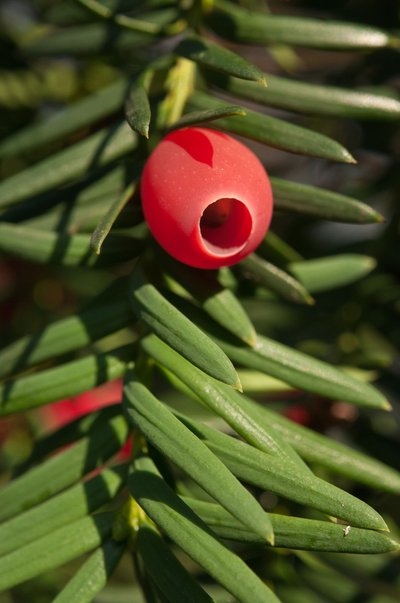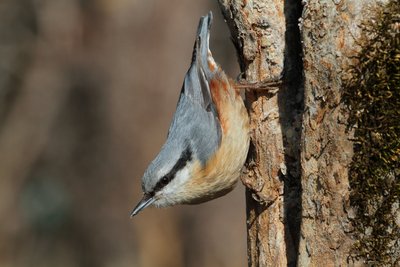About yew seeds and their distribution
In yew, the seed pod (aril) is a cup-shaped structure enclosing the seed (nucellus). The aril swells to create a fleshy red fruit-like structure called a false fruit. The red yew aril consists of 80 % water, 16.3 % sugar, 1.7 % proteins, plus additional pectins, organic acids and ash. It is the only taxine-free and therefore non-toxic component of the yew.
For many bird species, yew fruits with their fleshy, soft aril are of particular value. Especially mistle thrush (Turdus viscivorus), song thrush (Turdus philomelos), blackbird (Turdus merula), but also the fieldfare (Turdus pilaris), redwing (Turdus iliacus), starling (Sturnus vulgaris) and robin (Erithacus rubecula) eat the yew berries. The undigested seeds are excreted again in the slimy, dark red bird droppings. These bird species are thus known and important dispersers of yew.
It is less well known that the nuthatch is also one of the bird species that actively spread yew. However, the nuthatch is not interested in the aril, but only in the yew seed, which it pulls skilfully out of the aril and often hides in wall joints, bark cracks and rock crevices “for bad times to come”. It also uses these cracks and crevices to crack open harder seeds, as does the woodpecker.
This targeted searching for and hiding of yew seeds by nuthatches was observed and described very precisely by STÄGER as early as 1910. He also concluded that most of the yew germinating from rock crevices and wall joints is probably due to the seed-stashing activity of the nuthatch. These observations were verified and confirmed by the forester WILLE in 1913.
Yew trees found at the roots of trees, especially in twigs of main roots with deeply fissured bark, can also be traced back to the hiding of yew seeds by nuthatches.
Regeneration of beech and hornbeam on deadwood
However, the nuthatch also feeds on other tree seeds, e.g. beechnuts and hornbeam nuts. In times of plentiful food supply, it hides these too in the crevices and cracks of tree trunks. It also uses the cracks in the bark that open up in lying deadwood. So the frequent occurrence of beech or hornbeam regeneration on large lying deadwood trunks of beech is often due to the squirreling activity of the nuthatch.
If the degree of decay and decomposition of the wood has progressed to the point where sufficient moisture can be retained in the wood body, these seedlings can continue to grow; otherwise they dry out. In this way, the nuthatch also contributes to the regeneration of beech and hornbeam on deadwood.
It is known of the East Asian subspecies of our nuthatch (Sitta europaea amurensis) that a bird hides 8 to 28 seeds a day in autumn. From studies we also know that 9 nuthatches together hid and hoarded around 5,000 such seeds weighing a total of 2,500 g in the course of September and October. This enormous achievement can also be applied to the hiding of beechnuts or hornbeam nuts by nuthatch. This clearly shows the importance of the nuthatch in the spread of the yew, but also in the spread of the deciduous tree species beech and hornbeam in our forests.



